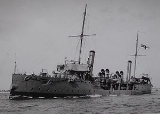
Dryad class torpedo gunboat
Encyclopedia
The Dryad-class torpedo gunboat was the last class of torpedo gunboat
Torpedo gunboat
In late 19th-century naval terminology, torpedo gunboats or, in north European usage, torpedo cruisers, were a form of gunboat armed with torpedoes and designed for hunting and destroying smaller torpedo boats...
built for the Royal Navy
Royal Navy
The Royal Navy is the naval warfare service branch of the British Armed Forces. Founded in the 16th century, it is the oldest service branch and is known as the Senior Service...
. This type of vessel was rapidly replaced by the faster torpedo boat destroyer, and all of the class were converted to minesweepers during World War I, with the exception of Hazard, which became a submarine depot ship.
Design
Ordered under the Naval Defence Act of 1889Naval Defence Act 1889
The Naval Defence Act 1889 was an Act of the Parliament of the United Kingdom, instituted on May 31, 1889 to increase the United Kingdom's naval strength and formally adopt the country’s "two-power standard." The standard called for the Royal Navy to maintain a number of battleships at least equal...
, which established the "Two-Power Standard", the ships were contemporary with the first torpedo boat destroyers, a type which subsequently superseded the torpedo gunboats. With a length overall of 262 in 6 in (80.01 m), a beam of 30 in 6 in (9.3 m) and a displacement of 1,070 tons, these torpedo gunboats were not small ships by the standard of the time; they were larger than the majority of World War I destroyers. They were equipped with two sets of vertical triple-expansion steam engines, with two locomotive-type boilers, driving through twin screws. This layout produced 3500 ihp (except Halcyon, which produced 6000 ihp), giving them a speed of 18.2 knots (35.7 km/h). They carried between 100 and 160 tons of coal and were manned by 120 sailors and officers.
Armament
The armament when built comprised two QF 4.7 inches (11.9 cm) gunsQF 4.7 inch Gun Mk I - IV
The QF 4.7 inch Gun Mks I, II, III, and IV were a family of United-Kingdom 120-mm naval and coast defence guns of 1888 and 1890s which served with the navies of various countries. They were also mounted on various wheeled carriages to provide the British Army with a long range gun...
, four 6-pdr guns and a single 5-barrelled Nordenfelt machine gun. Hussar as built mounted only one QF 4.7-inch gun, two 12-pdrs and one 6-pdr. The primary weapon was five 18-inch (450-mm) torpedo tubes
British 18 inch torpedo
There have been a number of 18 inch torpedoes in service with the United Kingdom. These have been used on ships of the Royal Navy and aircraft of both the Fleet Air Arm and Royal Air Force...
,British "18 inch" torpedoes were 17.72 inches (45.0 cm) in diameter with two reloads. On conversion to minesweepers in 1914 two of the five torpedoes were removed.
Ships
| Name | Ship Builder | Launched | Fate |
|---|---|---|---|
| Chatham Dockyard Chatham Dockyard Chatham Dockyard, located on the River Medway and of which two-thirds is in Gillingham and one third in Chatham, Kent, England, came into existence at the time when, following the Reformation, relations with the Catholic countries of Europe had worsened, leading to a requirement for additional... |
22 November 1893 | Tender to the Navigation School in 1906. Became a minesweeper in 1914. Relegated to harbour service and renamed Hamadryad in January 1918. Sold for breaking on 24 September 1920 | |
| Pembroke Dockyard | 17 February 1894 | Depot ship for submarines in 1901. Collided with the submerged submarine HMS A3 HMS A3 HMS A3 was an early Royal Navy submarine.She was a member of the first British A-class of submarines, although slightly bigger than the lead boat, . She was built at Vickers, Barrow-in-Furness and was commissioned on 13 July 1904. She was accidentally rammed whilst surfacing by the submarine tender... on 2 February 1912, killing 14 submariners. Sank in collision with SS Western Australia in the English Channel English Channel The English Channel , often referred to simply as the Channel, is an arm of the Atlantic Ocean that separates southern England from northern France, and joins the North Sea to the Atlantic. It is about long and varies in width from at its widest to in the Strait of Dover... on 28 January 1918 |
|
| Devonport Dockyard HMNB Devonport Her Majesty's Naval Base Devonport , is one of three operating bases in the United Kingdom for the Royal Navy . HMNB Devonport is located in Devonport, in the west of the city of Plymouth in Devon, England... |
20 February 1894 | Became a minesweeper in 1914. Sold for breaking on 23 February 1920 | |
| Devonport Dockyard | 6 April 1894 | Transferred to HM Coastguard in 1905. Became a minesweeper in 1914. Sold for breaking on 6 November 1919 | |
| Devonport Dockyard | 3 July 1894 | Became a minesweeper in 1914. Sold in December 1920 and resold for breaking on 13 July 1921 |

